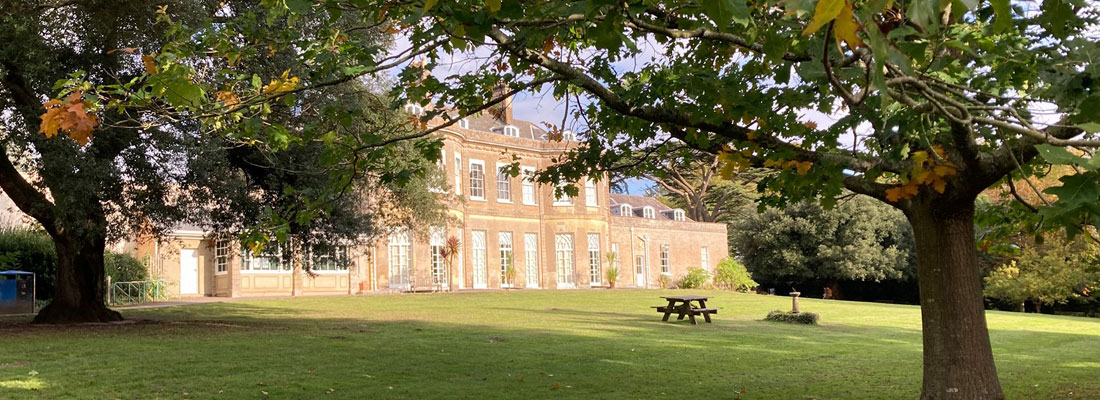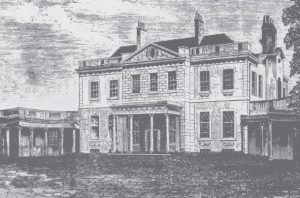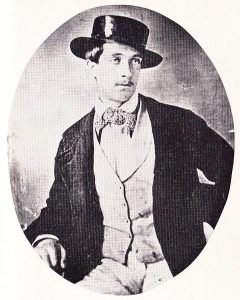
The History of Upton House
And the families that lived here

The Tichborne & Doughty period 1828-1901
Edward Doughty, who had been born Edward Tichborne, bought the House and Estate in 1828.

Upton House pre-1834
Edward was the third son of Baron Tichborne of Tichborne Park near Alresford, one of the oldest and richest families in Hampshire. He and his wife, the former Kathryn Seymour, were a quiet Catholic family, never very well known in Poole. In 1834 their only surviving child, Kathryn was born at Upton.
Like his brother James, the fourth son of the Baron, Edward had an allowance of £500 a year, and had started out life working on the Duke of Buckingham’s sugar plantations in Jamaica until, in 1826, to the astonishment of the whole family, he was left the wealth and estates of a fourth cousin named Elizabeth Doughty. A condition of the inheritance was that he took the name “Doughty” in the hope that he would have a son and continue the Doughty line. It was therefore important to purchase an appropriate house and estate.
Aged 46, he arrived at Upton, built extensions to Upton House including the provision of a family chapel in the east wing. He brought Andrew Bogle back with him from Jamaica; Andrew married a Poole girl named Elizabeth Young, and she worked at Upton House as nurse with Mrs Doughty.
Edward Doughty will be remembered for providing the coach to take the exiled King Charles X of France from Poole to Lulworth Castle in July 1830, and again when he sailed from Hamworthy for Scotland.
Mrs Doughty’s brother, Henry Seymour, became MP for Poole, and always stayed at the London Hotel in Poole’s High Street, but never set foot in Upton House, and was to take a prominent part in the misfortunes of his brother-in-laws family in later years.
Kathryn Doughty survived a serious illness, and in gratitude to God for her safe recovery, Edward had Poole’s first Catholic church built in West Quay Road, which could be seen by Mrs Doughty as she sat in the Drawing Room at Upton. At this time the railway had yet to be built, and there was an unfettered view across Holes Bay with Doughty’s Island on the left. Today the site is occupied by the Royal National Lifeboat Institute head office.

Roger Tichborne (c.1853-54)
Edward’s brother James Tichborne had married a half-English wife brought up in France named Henrietta. Their son Roger Tichborne born in France was sent to England to board at Stoneyhurst school, and he would spend his school holidays at Upton with his cousin. It was at Upton in 1848 at the end of his schooling that he studied for his entrance examination and in 1849 aged 20, joined the 6th Dragoon Guards, the Carabineers, after which he was stationed at Cahir near Waterford for the three years.
With the death of Baron Tichborne, the grandfather of Roger, the drama of the family started to unfold.
Henry the eldest son had seven daughters, none of whom could inherit the title, and had himself become Baron in 1821. The second son, Benjamin had died early. Edward was in line to succeed his brother Henry, and did so in 1845 to become the 9th Baron of Tichborne. Whilst in no hurry to leave Upton he would in due course be expected to take up the reigns at Alresford. The sale of Upton was a logical step, and Roger was the next in line. His father James, still living in Paris, agreed to the sale which required Roger’s signature and that could be accomplished as soon as he was of age in 1850. Roger, however, refused to sign, declaring his love both for Upton, and for his cousin “Katty” (Katherine Doughty). At this, in 1852, his Uncle Edward and Aunt Kathryn banned him from ever setting foot in Upton again.
Roger resigned his commission, prepared to sail to South America, and disappeared “presumed drowned”. Edward died in 1853 and James took the title until he too died in 1862 he died. Roger’s brother Alfred became the 11th Baron of Tichborne, but was made bankrupt in 1863. His mother, Henrietta, always refused to acknowledge the death of Roger and decided to advertise for news of him having heard rumours that he had made his way to Australia.
The “Tichborne Claimant” mystery
Thus began the famous Victorian legal cases relating to the “Tichborne Claimant”, and the man (referred to as Thomas Castro, also as Arthur Orton) who appeared in 1866 claiming to be Roger. Lady Tichborne accepted him as her lost son, and others became convinced, but her brother Henry Danby Seymour was violently opposed to the Claimant, and Alfred Seymour MP for Salisbury would also appear in the coming legal battle which eventually bankrupted the Tichborne Estates.
In May 1871, the battle was joined. 35,000 questions were asked in Court and on the 103rd day the case was stopped; “Roger” had a writ of perjury entered against him, he was arrested and taken to Newgate on 7th March 1872.
On 21 April 1873 the trial “Regina v Castro” commenced and, occupying 188 court days, was one of the lengthiest to be heard in an English court. On 28 February 1894 the court declared that the defendant was not Roger Tichborne and he was sentenced to two consecutive terms of seven years’ imprisonment. Within a month the Tichborne Estates Act was passed to pay the £92,000 legal costs out of the estate.
- Further reading: Tichborne case (Wikipedia)
Tenancies 1853-1901
Following the death of Sir Edward Tichborne, and during the period of the Tichborne Trials, Upton House was let to a series of tenants, starting in 1853 with the arrival of a niece of the family and her husband Lord Dormer.
In 1859 it was let to James Dearden, Member of Parliament for Rochdale.
By 1871, the Census shows that the Waters family was in residence, with the insight that this gives to the makeup of the household. Head of the house was Robert Edmund Chester Waters, aged 42, a Barrister (not practising) who had been born in London. His wife, Emily, was aged 41 and was born in Oxford. They had a daughter, Catherine, aged 18, born in London.
They were joined by Mary Lovey, a visiting Governess from Dublin, and resident in the house were 5 servants:
- the Butler, John Read, married, aged 43 born in South Molton, Devon,
- the Cook, Jessie Ganson, married, aged 56 born in the Shetland Isles,
- a Nurse, Sarah Jane Bishop, widow, aged 48 born in Shirehampton, Somerset,
- a Nurse, Jane King, married, aged 30, from Andover, Hants,
- a Housemaid, Elizabeth Young, unmarried, aged 21, from Poole.
A Robert Goff took on a short term tenancy in 1883.
John and Caroline Bengough, from Ridge in Gloucestershire, arrived in 1885 for their health. They came with their ten children suffering from consumption (known today as TB) and unhappily between 1887-1899 Caroline and several children died and were buried at St Michaels, Hamworthy. The one bright note during this time was the wedding on 5th April 1894 of daughter Cecil, who, aged 28, married the Rev Thomas Henry Philpott, aged 54, the Rector of Stockleigh Pomeroy, Devon. John returned alone to Gloucester.
The History of Upton House has been compiled and presented by The Friends of Upton Country Park
